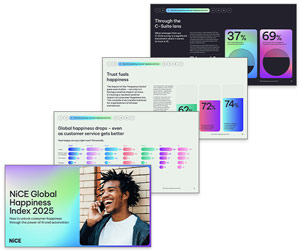A customer letter is a key form of business communication used for various purposes – whether it’s to thank a loyal customer, address a complaint, announce a new offer, or communicate a service update. A well-crafted letter not only delivers important information but also strengthens customer relationships.
So, how do you write a message that is clear, professional, and engaging? Whether you’re responding to feedback, sending a service notice, or simply expressing appreciation, we’ve compiled 22 essential tips to help you craft effective customer letters that make a lasting impression.
How to Improve Your Customer Service Letters
1. Write the Letter ASAP
If you are writing the letter in response to a specific event, such as a complaint, send the letter as soon as possible!
If it’s because of a first-time customer purchase (and you are quick enough), you could even put the letter in the box with the order, along with a discount coupon for a future purchase.
2. Never Use an Anonymous Greeting
Starting a letter with “Dear Valued Customer”, “Dear Valued Client”, “Dear Customer”, or “Dear Occupier” is not the way to show customers that you care.
Worst still is the use of “To all our valued customers”, as this clearly shows that their letter is a print run of 100s, if not 1,000s, all saying the same thing – with no care or attention to their personal situation.
Whilst undoubtedly quicker to implement, this approach will make people feel like ‘just a number’ – not a genuinely valued customer of your business.
So, what can you say instead of “dear valued customer”? If you really want to show a customer that you value them, use their name.
We know that it can be tempting to bulk print letters in advance, but try to avoid this if you can. It is good practice to personalise customer interactions to build relationships with customers, when possible.
For some great suggestions on personalising customer interactions, read our article: How to Personalise Customer Interactions
3. Don’t Risk Being Too Informal
It can be very tempting to adopt an informal approach to customer service letters but, particularly if you’re writing in the early part of the customer journey, it is better to stick to Mr/Mrs.
This follows suit of how agents address callers over the phone, as shown in the graph:
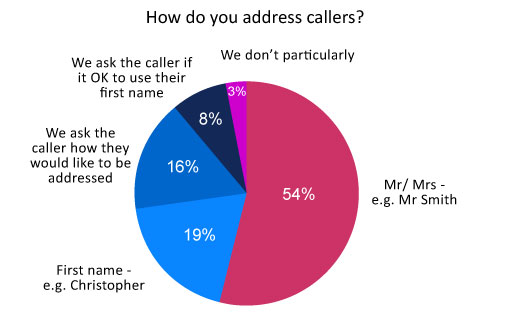
If you do not have good records on Mr/ Mrs, then try and keep it formal with the use of their full name, for example “Dear Alex Smith”.
The main exception to this is if calling the customer by their first name better suits your company’s brand image.
In this case, then there is certainly a case for doing so.
Top Tip
This all depends on the type of customer letter you are writing. If the letter has legal subtexts, it will be better to use Mr/Mrs for example. Whilst for writing a thank you letter, a first name may be more appropriate
To discover the ground rules for writing a thank you letter, read our article: How to Write a Thank-You Letter to a Customer – With Examples
4. Address Customers how THEY Would Like to be Addressed
Using “dear customer” or “dear valued customer” is really poor show if the letter you’re sending is in reply to a letter that was sent in by the customer.
In this instance, the title that they used for themselves to sign off their letter is the one that should be used in your response – however formal or informal. Always address the customer how they would like to be addressed, wherever possible.
5. Get Someone to Check the Name Is Right… Before Sending It Out!
Always make sure that you address people by their correct name. ALWAYS!
A sure-fire way to avoid problems like this is to get someone to check it before the letters go out.
This should help you solve problems such as “Dear Smith” syndrome, where someone’s surname has been wrongly entered into the database, or “Dear Donald Duck”, if people have entered a false name.
While this might sound time-consuming, it can pay dividends. Afterall, you do not want your basic mistakes to be the root cause of incoming customer complaints, or to be shared online – as we saw in this unfortunate example:
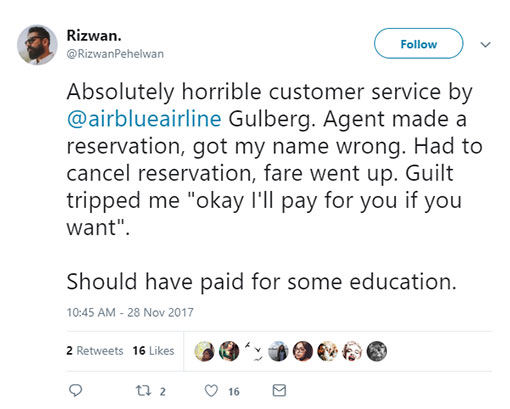
6. Thank Them for Their Custom
Too often, businesses take customers for granted and don’t thank them enough. However, it is very easy to add, “Thank you for your order” or “We appreciate your business” to your letters for a quick win.
You could even go one step further and come up with a less generic sign-off, to show a vested interest in the customer as an individual.
For example, if the customer has been with the company for 10 years, the letter could include a statement such as: “Thanks for your order and your 10+ years of support. It is greatly appreciated.”
For more ways to show courtesy on a call, read our article: The Best Courtesy Words and Phrases to Use in Customer Service
7. Offer Something in Return
If you really want to show that you value someone’s custom, then offering something in return can be very valuable.
Here are a few examples of nice bonuses to add to your customer letters:
- A £10 off voucher if you spend over £50 on your next order
- A code for 15% off your next order
- Free delivery on your next order
- A free copy of our magazine
A nice message to “set-up” these options for the customer would be something like “As a sign of our appreciation, I am enclosing…”
The use of the personal pronoun “I am” instead of “We are” also implies to the reader that the writer is interested in them as an individual.
This can make a difference, as creating the impression that they have an “insider” within the business is a great way of boosting customer loyalty.
Looking for ways to hold on to and create loyal customers, read our article: 11 Tips to Create and Maintain Loyal Customers
8. Place Important Information in the P.S. Section
It is often said that, after the title and / or headings, the second-most-read part of a letter is the P.S. section. In many cases, the person receiving the letter gives it little more than a quick scan before setting it aside.
Key information needs to be prominently displayed in a way that customers will notice. One way to approach this is to include an eye-catching P.S. section, after the main body of the text.
This might be a summary of the main message of your letter, advice on what steps the customer should take next, or details of the offer that you are providing.
9. Set Expectations With Clear Time Frames
Clearly stating your next steps and time expectations is crucial – particularly when handling complaints – as this helps to reassure customers, as well as prevent additional queries coming into your call centre.
This is particularly useful when handling complaints, as the customer is really only interested in ‘Are you listening to me?’, ‘Are you interested in me?’, and ‘What are you going to do about it and when?’.
10. Let Customers Know Who They Are Dealing With
Dealing with a faceless organisation is off-putting, so take simple steps to let your customers know exactly who they are dealing with.
One way to overcome this is for your advisors to introduce themselves by name, tell them something work-related about themselves, and personally thank them for their custom.
Take a look at the example below of an advisor who made sure that she added a distinctive and personal touch:

In the letter, “Lanny” mentions that she’s often given a nickname and that the customer can call her by that nickname too, adding a personal element to the letter. This is a great rapport-building tool.
It can also help to use personal pronouns like “I”, “you” and “we.”
11. Adopt a Clear and Striking Layout
Sometimes you will have a lot of information to deliver. Writing dense blocks of text, running to hundreds of words, practically guarantees that the reader will not be able to absorb it all.
Make sure the design of the letter helps to communicate your key messages – instead of hindering them – with good spacing and coloured boxes, for example.
12. Use Bullet Points to Break up Large Chunks of Information
In lengthy amounts of text, headings can be a good way to segment text and improve structure. Bullet points are also useful as they help to create better visual impact than large paragraphs of information.
When you open a letter and see only words and long paragraphs, it’s hard at first to understand what’s important.
13. Use Simple, Straightforward Language
Your company jargon will probably be so familiar to you that you forget how it is less clear to others. Making customers work to decode your correspondence is not going to encourage engagement.
Consumers interpret jargon as nonsense at best. At worst, they see it as dishonesty, because it can appear as though you are hiding your real meaning. Keep your message clear and direct, even in the fine print.
14. Be Upbeat!
Maintain a positive and welcoming tone throughout your letter, especially when delivering good news, offering solutions, or expressing appreciation.
An upbeat approach helps create a friendly and engaging experience for the customer. While being enthusiastic works wonders for promotions or thank-you notes, a gentler, more understanding tone is better suited for complaints or concerns.
Finding that sweet spot helps ensure your letter feels both friendly and professional, centred around what the customer needs.
If you are struggling to think of positive words and phrases to add into your letter, read our article: Positive Words and Phrases
15. Remind Customers How to Contact You
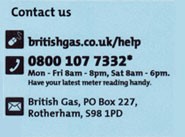
If a customer does need to contact you for further information, it should take as little effort as possible.
Customers should not need to seek out your details online if they have already received a letter from you.
You should display these details prominently on your correspondence, just like this example from British Gas.
16. Tell Customers How to Stop Receiving Letters
Customers are often keen to switch to other formats, as many of your letters will be looked at once and thrown away. However, customers are not likely to spend their own time finding out how to change to an alternative.
If you take the initiative and include information on switching in every letter, customers may very well take you up on it.
17. Hand-Sign the Letter
Nothing says that you value a customer more than hand-signing the letter.
Ideally, this should be in a different colour to the text. Blue ballpoint pen is quite good as it shows an impression on the page.
An alternative is to write the signature in fountain pen using water-soluble ink, so the reader (if they doubt that it is original) can smudge the ink.
This takes more effort, but if you are sending out fewer than 100 letters per day, it could prove a real return on investment.
Or, if the customer is really special, and you have the time to wow them, why not handwrite the whole thing? Customer service doesn’t get any more personal than that!
If you want an example of a great customer service letter, read our article: How to Write a Good Customer Service Letter – Example
18. Put Terms and Conditions on a Separate Page
If your letter includes detailed terms and conditions, consider placing them on a separate page or in an attachment.
This keeps the main message clear and easy to digest while ensuring the recipient isn’t overwhelmed by dense legal or technical information.
Instead of cluttering the letter, include a brief summary of the key terms and direct the reader to the full details elsewhere.
19. Convey Warmth in Your Letter
Part of what makes a customer appreciation letter so effective is the amount of warmth that it conveys. It humanizes your company.
Being warm is about being compassionate and approachable. Using words that convey empathy and spread kindness can go a long way towards helping you achieve that goal.
For examples of how to use empathy, take a look at our article on Empathy Statements for Customer Service With Examples

20. Write Down Each Point in Order of Importance to the Customer
All the key points of a customer service letter should be written in order of importance to the customer.
When customers write in, or even call in for that matter, they may describe things chronologically from beginning to end. But it might not be until the very last paragraph that they tell us what’s really important.
However, when writing a letter in response to a customer query, it is important to avoid responding to each issue “one by one” and instead take on the biggest problem first. This will help to ease the customer’s mind immediately.
Also, if a valuable freebie is offered along with the letter, it will likely be of strong interest to the customer. So, introduce the “freebie” closer to the top than the end.
Contributed by: Neil Martin
21. Take Ownership Using the Active Voice
It is important to stay in the active voice and not the passive.
To help check that you are using the active voice, add the words “by robots” to the end of every sentence that you write – as a simple test.
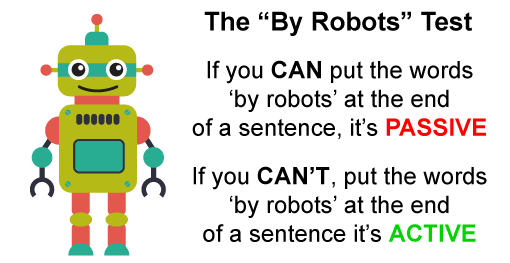
If the sentence still makes sense, then it is written in the passive voice. If it does not make sense, it’s written in the active voice.
For Example:
“Your case has been reviewed by robots” DOES make sense and is therefore passive.
So, it should be replaced by something like “I have looked over your case by robots”, which DOESN’T make sense and is therefore active.
For more great tips from Neil Martin, watch our Recorded Webinar: How to Give the Wow Factor on Email and Live Chat
Contributed by: Neil Martin
Looking for more top tips on customer service letters? Read these articles next:
- Dear Valued Customer – How NOT to Write a Customer Service Letter
- How to Write a Customer Apology Letter – With an Example
- Customer Service Emails and Letters: How to Review and Improve Your Templates
Author: Megan Jones
Reviewed by: Hannah Swankie
Published On: 23rd May 2018 - Last modified: 27th Aug 2025
Read more about - Hints and Tips, Customer Correspondence, Customer Service, Empathy, Language, Neil Martin, Rapport












